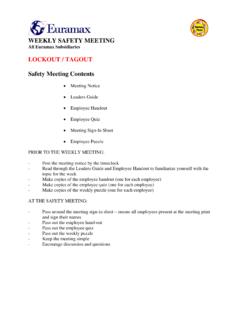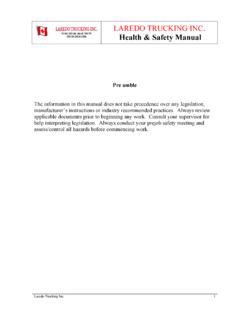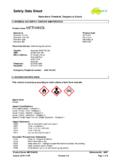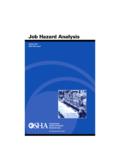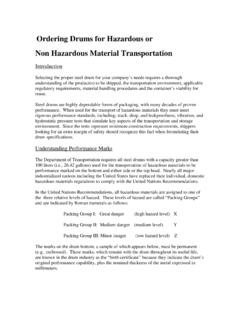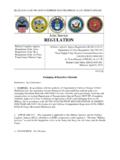Transcription of DOP Testing Procedure - EACO - Environmental …
1 EACO DOP / PAO Testing GUIDELINE 2013 Foreword The guideline promotes industry standards for training, equipment, and methodologies for HEPA filter integrity Testing of negative air units, vacuums and any other HEPA filtered equipment on abatement and remediation projects. This guideline is considered a recommended industry standard Procedure that can be utilized for Testing the efficiency of HEPA filtered equipment used in the control of hazardous materials. Disclaimer EACO disclaims any liability or risk resulting from the use of the work practices and recommendations discussed in the guideline. It is the user s responsibility to ensure that these apply to the specific workplaces and to ensure compliance with all other applicable federal, provincial and local acts and regulations. EACO DOP / PAO Testing GUIDELINE 2 | P a g e Table of Contents Section A - General Points and 3 Section B - 4 Section C - 6 Appendix I: Minimum Reporting Requirements Appendix II: Contract Specification Note for Consulting Members Appendix III: Illustrations EACO DOP / PAO Testing GUIDELINE 3 | P a g e Section A - General Points and Limitations 1) This document has been designed to address the Ontario hazardous Materials Abatement industry standards regarding DOP/PAO Testing of HEPA filtered negative air units, vacuums and any other HEPA filtered equipment used on-site to control hazardous particulate during abatement, remediation and construction projects.
2 2) This guideline will assist asbestos abatement supervisors in meeting the requirements of paragraph 18(4) 6 of Ontario Regulation 278/05 that states "The ventilation system referred to in subparagraph 5 i shall be inspected and maintained by a competent worker before each use to ensure that there is no air leakage, and if the filter is found to be damaged or defective, it shall be replaced before the ventilation system is used . 3) Below is a summary of recommended frequency based on current industry standards of acceptance: Negative Air Units Units should be tested for each project on-site where the exhaust from the units is vented indoors or near exterior HVAC systems. Negative air units should be tested a minimum of every 3 months regardless of location of exhausting and frequency of use. Negative air units should be tested whenever maintenance work is conducted such as changing or repair of HEPA filters, working on motors or any other maintenance that will affect the seal or integrity of the unit.
3 Vacuums Vacuums should be tested a minimum of every 3 months regardless of location of exhausting and frequency of use. 4) Contractors and service providers are to keep records of all scheduled maintenance related work. 5) Currently, the only known acceptable Testing equipment is manufactured by ATI (Air Techniques International). ATI manufactures acceptable and widely used aerosol generators and photometers. Please refer to ATI s website www. for additional information. Ensure your service provider follows all requirements as outlined in the manufacturer s specifications. 6) In order to check the accuracy of the DOP/PAO Testing Procedure , it is imperative that the service providers calibrate the equipment used for the procedures at least yearly. Service providers should provide records of calibration on a regular basis when conducting Testing . EACO DOP / PAO Testing GUIDELINE 4 | P a g e 7) In order to ensure the effectiveness of the DOP/PAO Testing Procedure , it is recommended that the service providers provide documentation to demonstrate that their field technicians have received training in the use of the Testing equipment and the required procedures for field Testing noted in this guideline.
4 In-house training should be provided by a competent person as defined by the OH&S Act. 8) Service providers should have adequate insurance for conducting DOP/PAO Testing Procedure and should be updated on a regular basis as required. Section B - Definitions Abatement procedures involving the removal, containment, control or treatment of hazardous materials. Aerosol Challenge Challenging of a filter or an installed filter system by test aerosol. Competent Person or Supervisor A person who is qualified because of knowledge, training and experience to organize the performance of hazardous materials abatement, is familiar with hazardous material Abatement procedures and has knowledge of the hazards of hazardous Materials and other dangers in the Abatement work area. DOP DOP or Dioctyl Phthalate is a liquid chemical which produces mono or poly -dispersed test aerosol of sub-micron particles, generated to challenge (evaluate integrity) of HEPA filters.
5 Designated Substance hazardous Materials (asbestos, lead, silica, mercury and others) designated by the Ontario Ministry of Labour for specific regulation under the Occupational Health and Safety Act. hazardous Materials Any material that, because of its quantity, concentration, or physical or chemical characteristics, may pose a real hazard to human health or the environment. HEPA Filtered Exhaust Fan Exhaust fan in sealed cabinet equipped with HEPA filtration used to exhaust filtered air out of an enclosed hazardous materials abatement work area for the purpose of establishing and maintaining a Negative Pressure in the hazardous materials Abatement work area with respect to surrounding areas, and also to provide general ventilation of the abatement area and also provide general ventilation to the abatement work area. EACO DOP / PAO Testing GUIDELINE 5 | P a g e HEPA Filtered Equipment Any form of equipment or device fitted with a ( micrometer) high efficiency particulate air filter removal system.
6 HEPA Filtered Vacuum A vacuum device fitted with a ( micrometer) high efficiency particulate arresting filter removal system. HEPA High Efficiency Particulate Arresting filter that is at least efficient in collecting a micrometer aerosol. HEPA filters to be pre-certified by the manufacturer and labeled. Installed Filter Leakage Test Test performed to confirm that the final filters are properly installed by verifying there is absence of bypass leakage in the installation, and the filters and system are free of defects and leakage. MSDS material Safety Data Sheet, required by Workplace hazardous Materials Information System (WHMIS) legislation. Gives information on hazardous materials, including properties, hazards, first-aid, emergency response, and personal protection. Mixing Chamber A small compartment placed in front of the negative air unit that assists in ensuring that the aerosol uniformly challenge the in-place HEPA filter.
7 Negative Pressure A reduced pressure established within a hazardous materials abatement enclosure relative to the area outside the enclosure by extracting air directly from Abatement area, and discharging this air outside the work area. The discharged air must be HEPA filtered, the exhaust unit should be leak-checked and preferably the air is discharged outside the building. PAO PAO or Poly Alfa Olefin is a monoor poly-dispersed test aerosol of sub-micron particles, generated to challenge (evaluate integrity of) of HEPA filters. EACO DOP / PAO Testing GUIDELINE 6 | P a g e Section C - Step-By-Step Procedure Step 1 The equipment being tested must be visually inspected to see that no major deficiencies can be detected, such as, cracked frame, holes from screws or rivets, damage to controls, etc. Turn equipment on to check that it is operating properly.
8 Visually check to see that the HEPA filter is properly installed. If possible, locate the test label from the factory to check that the HEPA filter meets or exceeds airflow and resistance of equipment utilizing the HEPA filter. The abatement contractor should also have this information recorded in the contractor's maintenance logbook for reference and inspection. Step 2 Turn on aerosol generator. Check that the unit has reached the correct temperature / PSI before using so that the correct particle size will be generated in accordance with the manufacturers specifications. Step 3 Initialize the aerosol generator and commence production of DOP / PAO. Direct DOP/PAO at the inlet/filter side of the unit to permit the HEPA unit to draw the media through the filter and blower (if Testing HEPA Vacuums please proceed to Step 6). The test aerosol should be introduced into the system to challenge the HEPA filter and seals on the upstream side of the filter.
9 This can be achieved with the aerosol passing through the mixing chamber, creating adequate mixing of the aerosol with the airflow in the duct or by directing the generated particles over entire filter media and around filter edges to test seal. Step 4 A sample of the DOP/PAO aerosol/air mixture should be taken from the upstream side, close to the filters under test to verify the necessary upstream challenge. This sample should also be used to set the 100% baseline. The 0% baseline is then adjusted using particle-free air supplied by the internal ULPA (Ultra Low Penetration Air) filter. The instrument is now ready to detect and quantify leaks on the downstream side of the filter. Step 5 The scanning test is performed using the hand held scanning probe. The probe is held or attached to the air exhaust of the unit. The Photometer display indicates the percent of leakage through or around the filter.
10 Step 6 HEPA Filtered Vacuum Cleaners and other equipment. The DOP / PAO aerosol mixture is introduced at the suction, mixed in the unit, and then passes through the filter. Step 7 The scanning test is performed using the hand held scanning probe. The entire exhaust area of the equipment is sampled by passing the probe in overlapping strokes across the face and perimeter of the exhaust. The end of the probe should be held within one inch of the exhaust and scanned at a traverse rate of no more than 10 feet per minute. The display indicates the percent of leakage through or around the filter or exhaust canister. EACO DOP / PAO Testing GUIDELINE 7 | P a g e Step 8 Labeling of machine as a pass DOP/PAO Test (HEPA Filter achieves efficiency) and hard copy documentation must be completed and provided to customer as noted in Appendix I. Step 9 For equipment that fails the DOP/PAO Test, no labeling is required and deficiencies are to be reported to the site supervisor.





